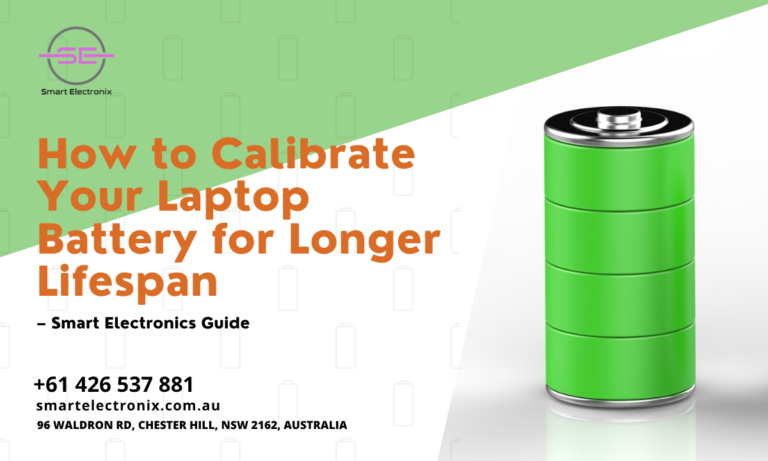
Ever feel like your laptop battery drains faster than it used to? Or maybe it says 30% left and then—bam!—it dies on you. These weird battery behaviors often stem from miscommunication between your battery and your system. Fortunately, there’s a simple yet powerful solution to improve battery performance: calibration.
At Smart Electronix, we believe in empowering users with knowledge to extend the life of their tech. In this guide, we’ll walk you through how to calibrate your laptop battery the right way—without any guesswork.
Why Calibrate Your Laptop Battery?
Laptop batteries use smart chips to estimate how much power is left. Over time, these estimations become less accurate. You might have 50% charge showing, but in reality, you’re down to 10%. Calibration realigns the battery’s reporting system, ensuring accurate power levels.
Not only does this help prevent sudden shutdowns, but it also helps the system manage power more efficiently—ultimately improving battery lifespan. Whether you own a Windows machine or a MacBook, battery calibration is a smart maintenance step.
Signs Your Battery Needs Calibration
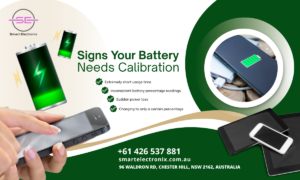
- Inconsistent battery percentage readings
- Sudden power loss
- Charging to only a certain percentage
- Extremely short usage time
If you’ve noticed any of these signs, it’s time to give your battery a fresh start.
Before You Begin: Preparation Steps
Before diving into the process, make sure to:
- Back up your work. Just in case your device shuts down during the process.
- Unplug external devices. Printers, USB drives, and even a mouse can interfere.
- Disable sleep/hibernate settings. You want the laptop to stay on while the battery drains.
How to Calibrate a Laptop Battery (Windows)
- Charge to 100%
- Plug your laptop in and charge it fully.
- Leave it plugged in for an additional 2 hours after reaching 100%.
- Change Power Settings
- Go to Control Panel > Power Options.
- Select “Change plan settings” > “Change advanced power settings”.
- Set battery critical level to 5%.
- Turn off sleep and hibernation features.
- Unplug and Drain
- Unplug your laptop and use it normally.
- Let it run until it shuts down on its own due to low battery.
- Cool Down
- Let the device sit off for 4–5 hours without charging.
- Recharge to 100%
- Plug it back in and charge it uninterrupted to full.
Congratulations! You’ve successfully recalibrated your Windows laptop battery.
Calibrating MacBook Battery (macOS)
Older MacBooks (pre-2015) benefit from calibration. Newer MacBooks use optimized battery charging, so manual calibration is rarely needed.
- Fully charge your MacBook
- Keep it plugged in for 2 more hours
- Unplug and use until battery is drained
- Leave it off for at least 5 hours
- Recharge fully before turning it on
Apple’s battery management is quite advanced, but recalibrating older models can still improve accuracy.
How Often Should You Calibrate?
Once every 2–3 months is sufficient for most users. If you use your laptop heavily or notice erratic battery behavior, consider recalibrating monthly.
Additional Battery Life Tips
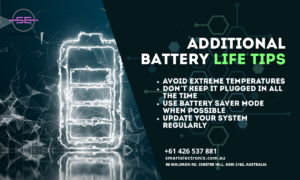
- Avoid extreme temperatures
- Don’t keep it plugged in all the time
- Use battery saver mode when possible
- Update your system regularly
Final Thoughts
Battery calibration is a simple yet effective way to keep your laptop running reliably. With the proper care and maintenance, your battery will serve you well for years. At Smart Electronix, we not only offer professional laptop repair services across Australia, but we also share valuable tech tips so you can get the most out of your devices.
Need help with a sluggish battery, overheating, or replacement options? Visit Smart Electronix or drop by our store for expert assistance.
Stay powered up—and smart!

Let’s be honest—nothing makes your heart sink quite like the sudden suspicion that your device is infected with malware. Whether it’s a sluggish system, pop-up ads, strange error messages, or unrecognized apps, malware infections can cause serious headaches. But don’t panic. At Smart Electronix, we believe in tackling these issues head-on while keeping your personal files safe and sound.
In this guide, we’ll walk you through a step-by-step process to detect and remove malware from your device without risking your documents, photos, or important data.
Step 1: Disconnect from the Internet Immediately
As soon as you suspect an infection, cut the malware off from the internet. This prevents it from spreading, downloading additional files, or transmitting your personal information.
- Turn off Wi-Fi or unplug your ethernet cable.
- Avoid connecting to any wireless networks.
This isolation move can be crucial in limiting the damage.
Step 2: Boot into Safe Mode
Running your system in Safe Mode loads only essential drivers and processes, making it easier to detect and eliminate malicious programs.
For Windows:
- Restart and hold Shift + F8 (or use Settings > Recovery > Advanced Startup).
- Select Safe Mode with Networking if a malware removal tool needs internet.
For Mac:
- Restart and hold the Shift key until the Apple logo appears.
Safe Mode gives you a clean environment to work in.
Step 3: Backup Personal Files Safely
Before diving into malware removal, create a backup of your personal files. But do it smartly:
- Use a clean USB or external hard drive.
- Only copy documents, images, videos, or project files.
- Avoid backing up software programs or system files that might carry malware.
If unsure, consult a professional like those at Smart Electronix to avoid backing up infected data.
Step 4: Use Reputable Malware Removal Software

Now, it’s time to run a deep scan using a trusted security solution. Here are a few reliable options:
- Malwarebytes
- Bitdefender
- Kaspersky
- Norton Power Eraser
Update the software before scanning. Run a full system scan, not just a quick one. Allow the tool to quarantine or delete any detected threats.
Step 5: Manually Identify Suspicious Applications
Sometimes, malware hides in plain sight under unfamiliar names. Look for unknown programs:
On Windows:
- Go to Control Panel > Programs > Uninstall a Program
- Sort by install date or name to spot odd software
On macOS:
- Go to Applications and review anything unusual
Remove anything you don’t recognize or trust.
Step 6: Check Browser Extensions and Settings
Browser hijackers are common malware. Reset your browser and remove suspicious add-ons:
- Clear cache and cookies
- Disable or delete unfamiliar extensions
- Reset homepage and default search engine settings
Keeping your browser clean is vital for online safety.
Step 7: Update Your Operating System and Software
Many malware attacks exploit outdated software. Once your system is clean:
- Update your operating system (Windows/macOS)
- Update browsers, security tools, and drivers
Staying current is one of the best forms of digital protection.
Step 8: Reconnect to the Internet and Monitor Behavior
After completing the cleaning process, reconnect to the internet. Observe your device for:
- Performance improvements
- Absence of pop-ups or redirects
- No strange background processes
If any suspicious activity returns, consider a professional malware cleanup service from Smart Electronix.
Extra Layer of Protection: Install Real-Time Antivirus
Preventing future infections is just as important as fixing current ones. Install a real-time antivirus with:
- Web protection
- Email scanning
- Ransomware shielding
- Regular updates
Many tools offer free and premium options depending on your needs.
When to Call the Experts at Smart Electronix
If things get too complicated or risky, don’t hesitate to reach out. At Smart Electronix in Chester Hill, NSW, our expert technicians can:
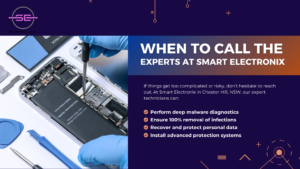
- Perform deep malware diagnostics
- Ensure 100% removal of infections
- Recover and protect personal data
- Install advanced protection systems
We’re only a click away at smartelectronix.com.au or call us at +61 426 537 881.
Final Thoughts
Dealing with malware is never fun, but it doesn’t have to be a nightmare. With the right approach and tools, you can eliminate threats and safeguard your data. Whether you prefer DIY solutions or need expert assistance, Smart Electronix is your go-to destination for secure and stress-free malware removal in Australia.
Stay secure. Stay smart.
Location: 96 Waldron Rd, Chester Hill, NSW 2162, Australia
Contact: +61 426 537 881
Website: smartelectronix.com.au
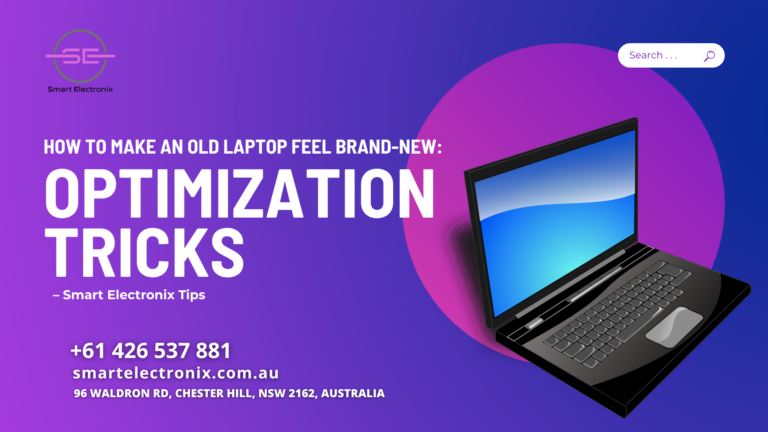
We’ve all been there—you press the power button on your trusty old laptop, only to wait… and wait. Tasks that once took seconds now drag on for minutes. But don’t toss it out just yet. At Smart Electronix, we believe even the oldest machines deserve a second chance. With the right optimization techniques, you can breathe new life into your aging laptop without breaking the bank.
1. Clean Up Storage Space
One of the most common reasons for a sluggish system is lack of storage space. Start by uninstalling programs you no longer use. Clean out temporary files, old downloads, and duplicate files. Tools like Disk Cleanup or third-party software such as CCleaner can automate this process efficiently. More free space often means faster performance.
2. Upgrade to a Solid-State Drive (SSD)
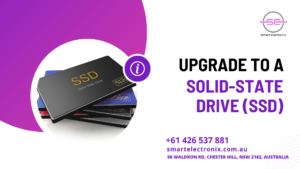 If your laptop still runs on a traditional hard drive, upgrading to an SSD is a game-changer. SSDs are faster, more durable, and use less power. This upgrade alone can significantly improve boot times, app launches, and file transfers.
If your laptop still runs on a traditional hard drive, upgrading to an SSD is a game-changer. SSDs are faster, more durable, and use less power. This upgrade alone can significantly improve boot times, app launches, and file transfers.
3. Maximize RAM Capacity
Another powerful upgrade is boosting your RAM. If your laptop struggles with multitasking or loading modern applications, increasing the memory can help. Check your laptop’s specifications to see the maximum RAM it supports and consider upgrading to the highest compatible size.
4. Remove Bloatware and Unwanted Programs
Many laptops come pre-installed with software you don’t need—bloatware that eats up system resources. Head to your Control Panel or Settings > Apps and remove anything that looks suspicious or unnecessary. Be cautious not to delete drivers or essential system software.
5. Manage Startup Programs
A bloated startup slows down your laptop’s boot time. Use the Task Manager (Ctrl+Shift+Esc) to navigate to the “Startup” tab and disable any programs that don’t need to run when the laptop boots. Only keep vital programs like antivirus software enabled.
6. Keep Your Software and Drivers Updated
Running outdated drivers and software can lead to compatibility issues and poor performance. Visit your laptop manufacturer’s website or use tools like Driver Booster to keep everything up to date. Also, ensure your operating system is regularly updated.
7. Scan for Malware and Viruses
Malware can quietly slow down your system or even steal sensitive information. Use trusted antivirus software to run full system scans. At Smart Electronix, we offer professional virus removal and diagnostics if you suspect deeper issues.
8. Optimize Power Settings
Your laptop’s power settings can also impact performance. Go to Control Panel > Power Options and select “High Performance” mode. While this uses more battery, it prioritizes speed over energy saving.
9. Tidy Up Your Desktop and Startup Folder
Too many icons on your desktop can slow down your boot process. Try organizing files into folders and minimizing what loads on startup. It’s a small step that can make a big difference.
10. Consider a Fresh OS Installation
If all else fails and performance is still lagging, a fresh installation of your operating system might be the ultimate solution. It wipes out accumulated junk and provides a clean slate. Be sure to back up important data first.
Final Thoughts
Your old laptop doesn’t need to be replaced—it just needs some care and attention. By following these optimization tricks from Smart Electronix, you can extend your device’s life, improve performance, and save money.

If you’re unsure where to start or want expert help, visit Smart Electronix in Chester Hill, NSW. Our technicians can assess, upgrade, and optimize your laptop for peak performance. It’s time to revive your device and enjoy using it again—without the frustration.
Smart Electronix – Where old tech feels brand new.
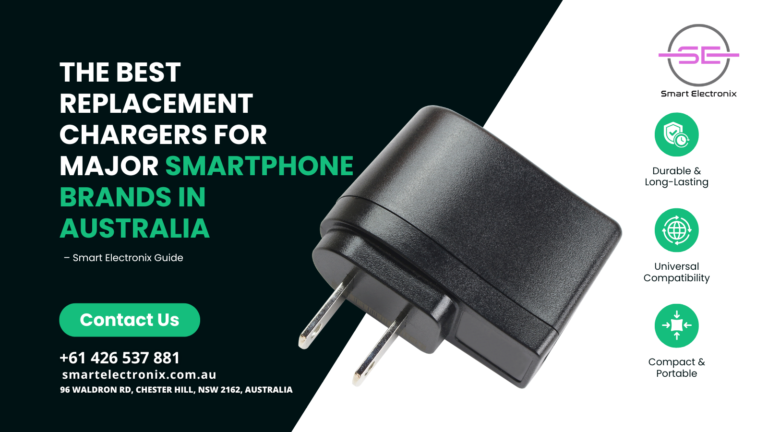
Let’s face it—nothing is more annoying than a smartphone charger that suddenly stops working. Whether you’re dealing with frayed cables, slow charging, or overheating adapters, finding the right replacement charger can save you time, money, and frustration. At Smart Electronix, we know how vital a reliable charging solution is, especially for Australians constantly on the move.
This 2025 guide is here to help you choose the best replacement chargers for popular smartphone brands available in Australia.
Why Choosing the Right Charger Matters
Not all chargers are created equal. Using the wrong charger can:
- Damage your phone’s battery over time
- Charge your device slower than expected
- Cause overheating or safety hazards
- Void your device’s warranty
High-quality chargers deliver optimal power output and come with built-in safety features that protect both your device and your data.
Best Replacement Chargers by Smartphone Brand
1. Apple (iPhone)
Apple devices require chargers that support USB Power Delivery (PD) for fast, efficient charging.
Recommended:
- Apple 20W USB-C Power Adapter
- Anker Nano II 30W USB-C Charger
- Belkin BOOST↑CHARGE USB-C PD GaN Charger
Cable Tip: Use MFi-certified Lightning cables to ensure compatibility and safety.
2. Samsung (Galaxy Series)
Samsung smartphones often use Adaptive Fast Charging or Super Fast Charging protocols.
Recommended:
- Samsung 25W USB-C Super Fast Charger
- Spigen 45W USB-C GaN Charger
- Baseus 30W USB-C Charger
Cable Tip: Look for USB-C to USB-C cables that support 3A or higher.
3. Google Pixel
Pixel phones are optimized for USB PD fast charging.
Recommended:
- Google 30W USB-C Power Adapter
- Anker PowerPort III 65W
- UGREEN Nexode 45W USB-C Charger
Cable Tip: Ensure the cable is USB PD compatible for maximum performance.
4. Oppo/Vivo/Realme
These phones often feature VOOC or Dart fast-charging technology. Proprietary tech means generic chargers may not deliver full speed.
Recommended:
- Original VOOC/Dart chargers from Oppo/Realme
- Aukey Omnia 65W for universal compatibility
Cable Tip: Always use OEM or brand-certified cables for full-speed charging.
5. Xiaomi/Redmi/POCO
Xiaomi phones support Qualcomm Quick Charge or USB PD depending on the model.
Recommended:
- Xiaomi 33W Fast Charger
- Tronsmart 36W Dual USB Charger
- ZMI 65W GaN USB-C Charger
Cable Tip: USB-C to USB-C cables with QC or PD support offer best results.
Universal Chargers: Are They Worth It?
If you own multiple devices from different brands, investing in a universal charger can be a smart move. Look for these features:
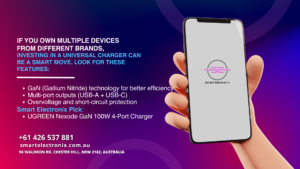
- GaN (Gallium Nitride) technology for better efficiency
- Multi-port outputs (USB-A + USB-C)
- Overvoltage and short-circuit protection
Smart Electronix Pick:
- UGREEN Nexode GaN 100W 4-Port Charger
Tips for Buying Chargers in Australia
- Check Certification: Look for RCM (Regulatory Compliance Mark) to ensure the product meets Australian safety standards.
- Avoid Fake Chargers: Cheap, unbranded chargers can be dangerous.
- Buy from Trusted Retailers: Visit SmartElectronix.com.au for high-quality, verified products.
- Verify Compatibility: Double-check voltage, wattage, and connector type before purchasing.
Final Thoughts
With so many replacement charger options available, it’s easy to get overwhelmed. But when you choose certified, high-quality chargers tailored for your phone, you protect your device and extend its lifespan.
Smart Electronix offers a curated range of reliable charging solutions for all major smartphone brands in Australia.
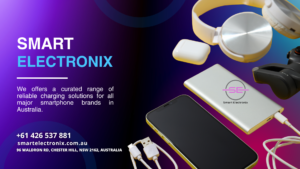
Whether you need a fast USB-C charger for your Galaxy or a safe Lightning cable for your iPhone, we’ve got your back.
Still unsure? Reach out to our support team or visit our store in Chester Hill, NSW. We’re always happy to help you power up safely and efficiently.
Smart Electronix – Australia’s Trusted Tech Repair & Accessory Experts
Address: 96 Waldron Rd, Chester Hill, NSW 2162, Australia
Phone: +61 426 537 881
Website: SmartElectronix.com.au
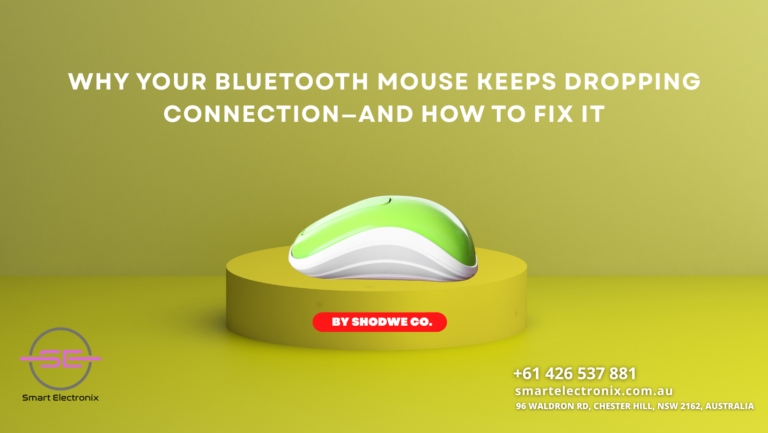
Have you ever found yourself in the middle of a task only to have your Bluetooth mouse suddenly stop working? We’ve all been there—whether you’re studying, gaming, or handling important work documents. A disconnecting mouse is more than just a nuisance; it can hinder your productivity. At Smart Electronix, we see this issue frequently and know exactly how to address it. Here’s your complete guide to understanding why it happens and what to do about it.
Common Reasons Your Bluetooth Mouse Disconnects
1. Low Battery Power
Bluetooth mice rely heavily on stable battery power. Weak or dying batteries can disrupt the connection frequently.
Quick Fix: Try replacing your mouse battery or recharging it fully.
2. Driver Issues
Outdated or corrupted drivers can cause repeated disconnections between your mouse and computer.
Smart Fix: Head to your device manager and update your Bluetooth and mouse drivers.
3. Power Management Settings
Many operating systems are configured to turn off idle devices to save energy—this includes your Bluetooth mouse.
Pro Tip:
- Go to Device Manager
- Expand “Bluetooth”
- Right-click your mouse
- Select “Properties” > “Power Management”
- Uncheck “Allow the computer to turn off this device to save power”
4. Interference From Other Devices
Your Bluetooth mouse operates on a 2.4GHz frequency, which is shared by many other wireless devices.
Smart Tip: Keep your mouse and receiver away from USB 3.0 ports and other wireless gadgets.
5. Outdated Operating System
Sometimes, the issue is with your OS rather than the hardware. Regular updates can solve this problem.
What to Do: Ensure your operating system is up to date and restart your device.
How to Troubleshoot and Resolve It
 Step-by-Step Guide:
Step-by-Step Guide:
Step 1: Reboot Your Devices
A quick restart often resolves temporary glitches.
Step 2: Re-pair the Mouse
- Go to Bluetooth settings
- Remove the device
- Reconnect it by putting your mouse in pairing mode
Step 3: Test on Another Computer
This will help you determine if the issue is with the mouse or your computer.
Step 4: Check for Firmware Updates
Some mouse manufacturers offer firmware updates that can improve performance.
Step 5: Consider Environment Factors
If you’re in a crowded workspace with many wireless devices, try moving to a less cluttered area.
When to Seek Professional Help
If you’ve tried all the above and your mouse still keeps disconnecting, it might be a hardware issue.
At Smart Electronix, We Offer:
- Bluetooth connectivity diagnostics
- Driver updates and repairs
- Component replacements
- Fast turnaround times
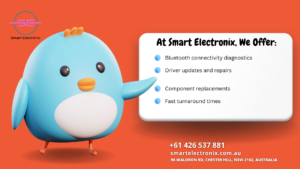 Visit Us:
Visit Us:
96 Waldron Rd, Chester Hill, NSW 2162, Australia
Call Now: +61 426 537 881
Website: SmartElectronix.com.au
Why Fixing It Matters
A stable Bluetooth connection ensures smooth scrolling, accurate clicks, and reliable productivity. Don’t let a small issue slow you down when a quick fix or a professional check-up could solve it easily.
Final Thoughts from Smart Electronix
Whether you’re tech-savvy or just want a dependable setup, understanding why your Bluetooth mouse keeps disconnecting helps you take the right action. If DIY steps don’t help, let Smart Electronix give you a hand. We’re here to keep your devices running at their best.
Stop by our store or give us a call to book a diagnostic service today!
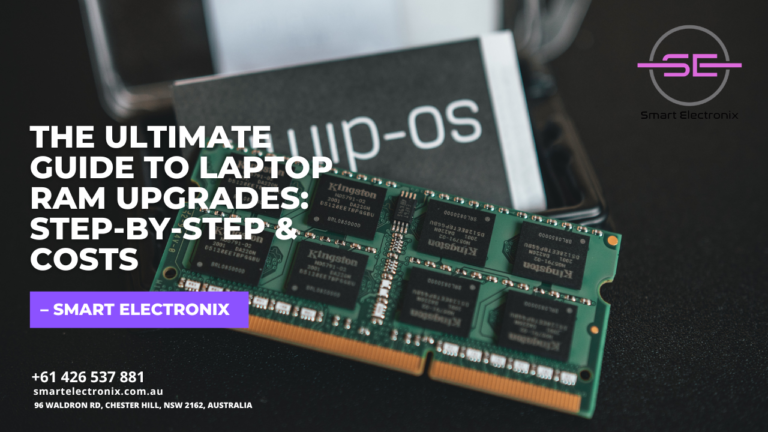
Let’s be honest—nothing is more frustrating than a sluggish laptop, especially when you’re juggling multiple tabs, working on important projects, or streaming your favorite shows. At Smart Electronix, we know that upgrading your RAM (Random Access Memory) is one of the easiest and most effective ways to breathe new life into your laptop. Whether you’re a student, freelancer, gamer, or business professional, boosting memory can dramatically improve system performance.
In this comprehensive guide, we’ll walk you through everything you need to know about laptop RAM upgrades—from how to check compatibility to the tools required and the average cost in Australia.
What Is RAM and Why Upgrade It?
RAM temporarily stores data your computer needs to access quickly. The more RAM you have, the smoother your laptop runs when multitasking or running memory-heavy applications like video editors or design software.
Benefits of a RAM Upgrade:
- Faster app loading times
- Smoother multitasking
- Improved system responsiveness
- Better gaming performance
- Future-proofing your device for years to come
How to Check Your Laptop’s RAM Capacity
Before buying new RAM, you need to know how much your system already has and what it supports.
Here’s how:
- Windows: Press
Ctrl + Shift + Esc to open Task Manager, then click on the “Performance” tab.
- Mac: Go to “About This Mac” > “Memory.”
You’ll see how much RAM is currently installed, how many slots are available, and your RAM speed (MHz).
Step-by-Step RAM Upgrade Process
Upgrading laptop memory isn’t as hard as it sounds—but it does require careful handling.
Tools You’ll Need:

- Anti-static wrist strap
- Screwdriver (usually Phillips-head)
- Compatible RAM stick (check your laptop specs)
Step-by-Step Guide:
- Turn off your laptop and unplug it.
- Remove the battery (if it’s detachable).
- Discharge static electricity by touching a metal object or wearing an anti-static wristband.
- Unscrew the back panel to access the RAM slots.
- Locate the RAM slots—they look like tiny circuit boards held in place by metal clips.
- Remove the old RAM by gently pushing the clips outward.
- Insert new RAM at a 30-degree angle and press down until it clicks.
- Reassemble your laptop and power it on.
Your system should automatically detect the new memory. To confirm, go back to the “Performance” tab in Task Manager.
What Type of RAM Do You Need?
Choosing the right type of RAM is crucial. Most laptops use DDR4, but older models may use DDR3.
Check the following:
- Form factor: SO-DIMM (for laptops)
- Type: DDR3, DDR4, or DDR5
- Speed: Measured in MHz (e.g., 2400 MHz, 3200 MHz)
- Maximum capacity: Check your laptop manual or manufacturer website
How Much RAM Is Enough?

Here’s a basic guideline:
- 4GB: Basic tasks like browsing and document editing
- 8GB: Ideal for students and general office use
- 16GB: Great for multitasking, content creation, and light gaming
- 32GB+: For video editing, heavy gaming, and professional software
How Much Does It Cost in Australia?
RAM prices vary based on size and brand. Here’s what to expect:
| RAM Size |
Approximate Cost (AUD) |
| 4GB DDR4 |
$25 – $45 |
| 8GB DDR4 |
$45 – $70 |
| 16GB DDR4 |
$80 – $130 |
| 32GB DDR4 |
$150 – $250 |
If you’re unsure which one to buy, visit Smart Electronix or contact us for personalized guidance.
Should You DIY or Get Expert Help?
While upgrading RAM is relatively straightforward, some users prefer professional service.
DIY Pros:
- Cheaper
- Quick for those who are tech-savvy
Expert Service Pros:
- No risk of damaging components
- Guaranteed compatibility
- Time-saving
At Smart Electronix, we offer:
- Full diagnostic checks
- Compatibility verification
- Installation by certified technicians
- Service warranty on parts and labor
📍 96 Waldron Rd, Chester Hill, NSW 2162, Australia
📞 +61 426 537 881
🌐 smartelectronix.com.au
Final Thoughts
Upgrading your laptop’s RAM is a smart move for anyone looking to enhance performance and extend their device’s life. Whether you’re doing it yourself or trusting the experts at Smart Electronix, understanding the steps, costs, and benefits puts you ahead of the game.
Ready to upgrade? Visit our store or give us a call for professional advice and hands-on support. We’re here to make tech easier, faster, and smarter—just like your upgraded laptop will be.
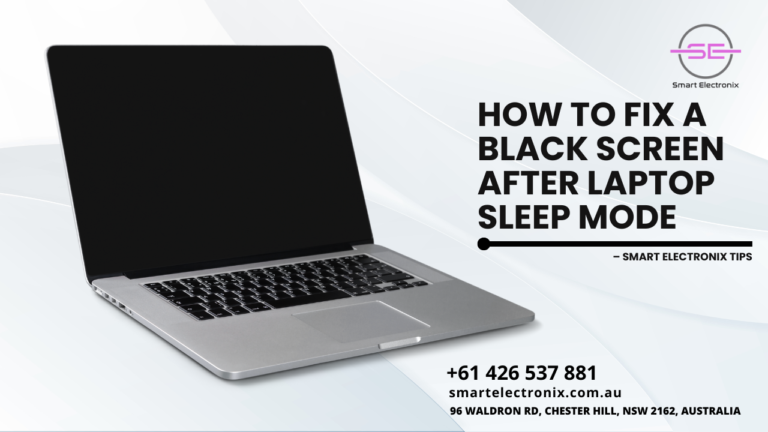
Ever closed your laptop lid for a quick break, only to return and find the screen stays black? You’re not alone. This issue, while common, can be alarming—especially when you’re in the middle of important work. At Smart Electronix, we’ve helped hundreds of Australians troubleshoot sleep mode glitches. In this guide, we’ll walk you through why this happens and how to solve it without stress.
Why Does the Screen Stay Black After Sleep Mode?
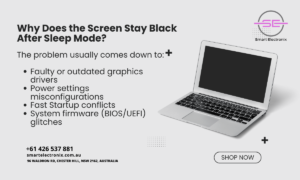 The problem usually comes down to:
The problem usually comes down to:
- Faulty or outdated graphics drivers
- Power settings misconfigurations
- Fast Startup conflicts
- System firmware (BIOS/UEFI) glitches
These issues prevent the system from properly waking up, leaving the display unresponsive.
Step 1: Perform a Hard Reset
Start with the simplest solution. A hard reset clears temporary configurations.
Here’s how:
- Shut down your laptop completely.
- Disconnect the charger and remove the battery (if applicable).
- Hold the power button for 10–15 seconds.
- Reconnect power and boot the device.
This often solves temporary sleep-wake cycle issues.
Step 2: Update Display Drivers
Outdated or corrupt graphics drivers are a top cause.
To update:
- Press Ctrl + Shift + Esc to open Task Manager.
- Go to File > Run new task, type
devmgmt.msc, and hit Enter.
- Expand Display adapters > Right-click your GPU > Update driver.
- Choose Search automatically for drivers.
Smart Electronix Pro Tip: Visit the manufacturer’s site (Intel, NVIDIA, AMD) for the latest driver version.
Step 3: Disable Fast Startup
Fast Startup can cause wake-from-sleep problems, especially in Windows 10 and 11.
To disable:
- Go to Control Panel > Power Options > Choose what the power buttons do.
- Click Change settings that are currently unavailable.
- Uncheck Turn on fast startup.
- Save changes and restart.
Step 4: Adjust Power Settings
Misconfigured power settings can lead to black screen errors post-sleep.
Try this:
- Go to Settings > System > Power & Sleep > Additional power settings.
- Select Balanced, then click Change plan settings.
- Click Change advanced power settings.
- Under Display, set “Turn off display after” to a higher value.
- Make sure Sleep > Allow hybrid sleep is turned OFF.
Step 5: BIOS/UEFI Firmware Update
Sometimes, your laptop’s firmware isn’t properly managing sleep/wake cycles.
To check:
- Press Windows + R, type
msinfo32, and hit Enter.
- Note your BIOS version/date.
- Visit your laptop manufacturer’s website and download any newer firmware update.
Follow instructions carefully, as incorrect BIOS updates can harm your device.
Step 6: External Display Test
You might not have a black screen—it could be displaying on the wrong monitor.
Do this:
- Plug in an external monitor.
- Press Windows + P and toggle through display options.
If visuals appear on the second screen, adjust display settings to detect and use the main screen properly.
Step 7: Restore Default Power Profiles
Corrupted power plans may need a reset.
Use Command Prompt:
- Open Start Menu > type
cmd > Run as administrator.
- Type:
powercfg -restoredefaultschemes and hit Enter.
This will restore Windows’ default power plans.
Still Not Fixed? Let Smart Electronix Help
If none of these solutions work, you might have deeper hardware issues—like a failing motherboard, GPU, or backlight inverter.
At Smart Electronix, we offer:
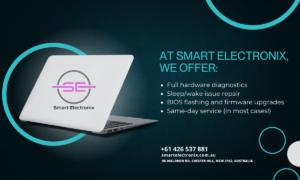
- Full hardware diagnostics
- Sleep/wake issue repair
- BIOS flashing and firmware upgrades
- Same-day service (in most cases!)
📍 Location: 96 Waldron Rd, Chester Hill, NSW 2162
📞 Contact: +61 426 537 881
🌐 Website: smartelectronix.com.au
Final Thoughts
Sleep mode should be convenient—not frustrating. Now that you’re armed with the right troubleshooting tools, you can bring your laptop back to life with confidence. And if you’d rather not risk it, bring it in to Smart Electronix, where we fix black screen problems the smart way.
Need support today? Visit us or book a repair online. Your laptop deserves better rest and even better wakeups!
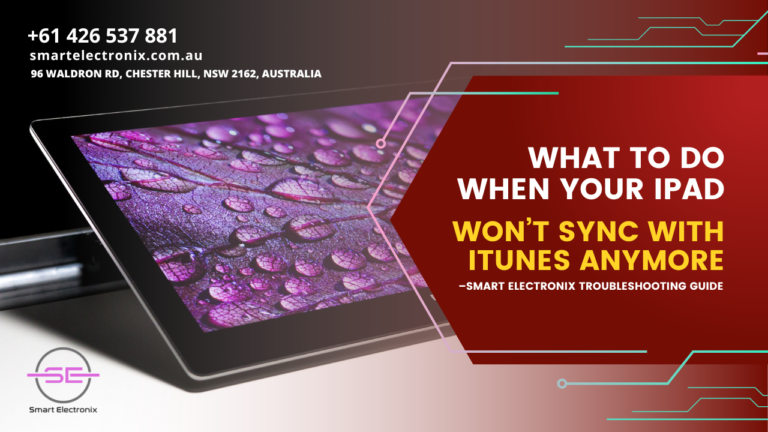
It’s a frustrating moment: you plug your iPad into your computer, expecting a smooth sync with iTunes, only to find nothing happens. Whether you’re trying to update music, transfer files, or create a backup, syncing issues can be a real headache. At Smart Electronix, we understand how important seamless device connectivity is, especially when you’re counting on iTunes to manage your Apple content.
This comprehensive guide will help you troubleshoot and fix the issue, whether it’s a simple glitch or something more complex. Let’s dive into the possible reasons—and solutions—for why your iPad won’t sync with iTunes anymore.
Step 1: Update Everything
The most common cause of sync failure is outdated software. Syncing issues are often resolved by ensuring both your iTunes software and iPad are updated.
What to Check:
- iTunes Version: Make sure you have the latest version of iTunes installed on your computer.
- macOS or Windows Updates: Outdated operating systems can conflict with device syncing.
- iPad iOS: On your iPad, go to Settings > General > Software Update.
Smart Electronix Tip: Always restart your devices after updating.
Step 2: Check the Connection
Your cable or port might be the problem. A faulty Lightning cable or USB port can prevent your iPad from syncing.
Quick Fixes:
- Try a different USB port.
- Use a certified Apple Lightning cable.
- Avoid USB hubs; plug directly into your computer.
- Clean the charging port on your iPad.
If your iPad still doesn’t show up in iTunes, try a different computer to isolate the problem.
Step 3: Trust the Device
When connecting to a new or recently updated computer, your iPad should prompt you with a “Trust This Computer?” message. If you accidentally hit “Don’t Trust,” syncing will fail.
How to Fix:
- Disconnect your iPad.
- Go to Settings > General > Transfer or Reset iPad > Reset > Reset Location & Privacy.
- Reconnect and select “Trust” when prompted.
Step 4: Restart Apple Services
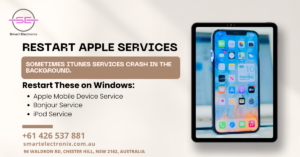
Sometimes iTunes services crash in the background.
Restart These on Windows:
- Apple Mobile Device Service
- Bonjour Service
- iPod Service
You can do this via Task Manager or Services.msc.
On macOS, try restarting the computer and relaunching iTunes.
Step 5: Reinstall iTunes
If nothing else works, a clean reinstall of iTunes may do the trick.
How to Reinstall Safely:
- Uninstall iTunes and all related Apple software (Apple Software Update, Bonjour, etc.).
- Reboot your system.
- Download the latest version directly from Apple.
Smart Electronix Reminder: Always back up your iTunes library before uninstalling.
Step 6: Check for Driver Issues (Windows Only)
Sometimes the Apple Mobile Device USB driver isn’t recognized.
How to Check:
- Plug in your iPad.
- Open Device Manager.
- Look under “Universal Serial Bus controllers” or “Portable Devices.”
- If you see a warning icon, right-click > Update driver.
Step 7: Explore Alternatives
Still no luck? You can use other tools to manage your iPad:
- Finder (macOS Catalina and later)
- iCloud Drive for file sync
- Third-party apps like iMazing or AnyTrans
But if you need reliable, fast help, professional diagnostics may be the best step.
When to Visit Smart Electronix
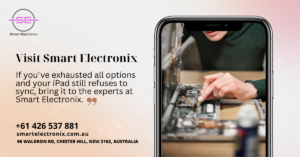
If you’ve exhausted all options and your iPad still refuses to sync, bring it to the experts at Smart Electronix. We offer:
- Thorough diagnostic testing
- USB port repair and replacement
- iOS reinstall services
- Fast turnaround and clear pricing
📍 Visit Us: 96 Waldron Rd, Chester Hill, NSW 2162
📞 Call: +61 426 537 881
🌐 Website: smartelectronix.com.au
Final Thoughts
Syncing your iPad with iTunes should be seamless—but when it’s not, these steps can help you get back on track. With patience and the right troubleshooting, you can usually resolve the issue yourself. And if not, Smart Electronix is here to help, offering expert-level service with customer-focused care.
Don’t let sync errors interrupt your digital life. Contact us today and keep your Apple experience running smoothly!
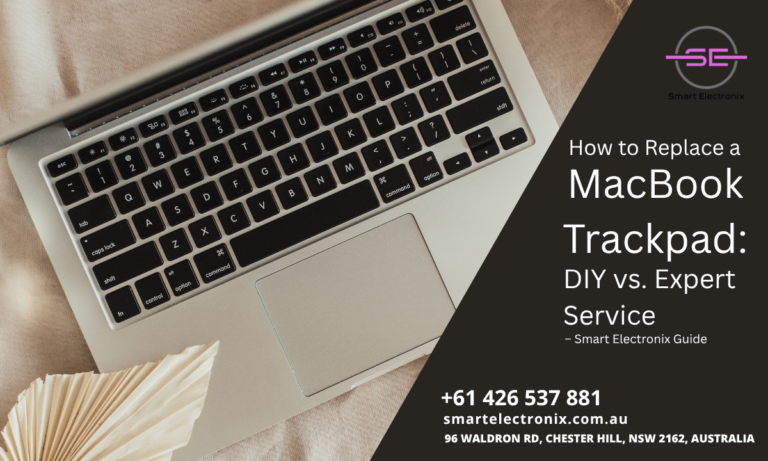
Trackpad acting up? Maybe it’s unresponsive, clicking inconsistently, or just behaving strangely. If you’re a MacBook user, this can be more than a minor annoyance. At Smart Electronix, we often help clients decide: should you replace a MacBook trackpad yourself or trust the pros? In this guide, we break down both options so you can make an informed, cost-effective decision.
Common Signs Your MacBook Trackpad Needs Replacement
Before jumping into repairs, make sure the issue isn’t software-related. A macOS update, corrupted drivers, or settings misconfiguration could be the culprit.
Hardware symptoms include:
- No click or haptic feedback
- Cursor jumping or freezing
- Physical cracks or liquid damage
- Clicking on its own (phantom input)
If any of these sound familiar, a trackpad replacement might be in your future.
Option 1: DIY MacBook Trackpad Replacement
Pros:
- Cost Savings: Replacing the trackpad yourself will generally cost less in labour.
- Learning Experience: Tech-savvy users enjoy the hands-on approach.
Cons:
- Risk of Damage: One slip and you might damage nearby components, especially the battery.
- Complex Assembly: Apple doesn’t make it easy. Newer models require disassembling the entire device.
- Warranty Void: Any unauthorized opening may void your Apple warranty.
Tools You Need:
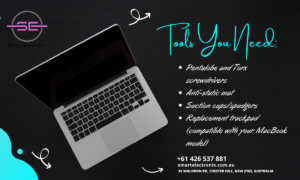
- Pentalobe and Torx screwdrivers
- Anti-static mat
- Suction cups/spudgers
- Replacement trackpad (compatible with your MacBook model)
Basic Steps:
- Backup your MacBook
- Power off and disconnect all cables
- Remove bottom case screws
- Disconnect the battery connector
- Remove and replace the faulty trackpad
- Reassemble and test
Smart Electronix Note: We only recommend this for experienced users. A misstep can lead to expensive repairs.
Option 2: Expert Service from Smart Electronix
Sometimes, it’s better to leave it to the professionals.
Why Choose Us?

- Certified Technicians: Experienced with all MacBook models
- Genuine Parts: High-quality, compatible replacements
- Quick Turnaround: Most repairs done within 24-48 hours
- Warranty Included: On both parts and labour
What We Do:
- Full diagnostics to ensure trackpad is the issue
- Battery inspection and thermal checkup (at no extra charge)
- Precision trackpad replacement
- System calibration to ensure full responsiveness
Address: 96 Waldron Rd, Chester Hill, NSW 2162, Australia
Phone: +61 426 537 881
Website: smartelectronix.com.au
Cost Comparison
| Repair Option |
Approximate Cost |
Risk |
Turnaround Time |
| DIY |
$50-$100 AUD |
High |
3-6 hours |
| Smart Electronix |
$150-$200 AUD |
Low |
1-2 days |
When factoring in tools, parts, and time, professional service often proves more cost-effective long term.
How to Decide
If you’re confident with delicate repairs and have experience with MacBook internals, DIY can work. But if you want peace of mind, safety, and guaranteed results, Smart Electronix is your best bet.
Final Thoughts
Replacing a MacBook trackpad might seem like a straightforward task, but it’s more complex than many expect. Whether you go the DIY route or leave it to the experts at Smart Electronix, knowing the pros and cons helps you make the right choice.
Need help with a faulty MacBook trackpad? Visit SmartElectronix.com.au or give us a call today. We’re here to help you get your MacBook working like new again!
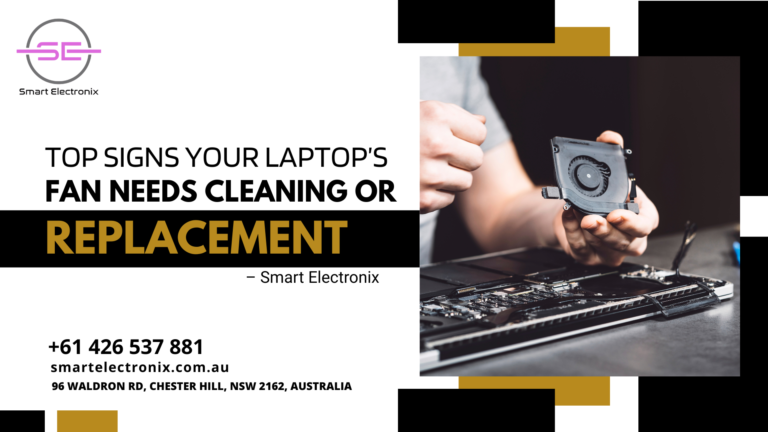
We’ve all heard it: that sudden, loud whirring noise coming from your laptop when it seems like it’s about to take flight. While it might be easy to ignore, a noisy or sluggish laptop fan is often a cry for help. At Smart Electronix, we’re big believers in listening to your tech before a small problem becomes a major issue.
In this guide, we’ll walk you through the top signs your laptop fan needs attention, what causes the problems, and how to clean or replace it safely.
Why Laptop Fans Matter
A laptop fan plays a critical role in managing internal temperature. It helps dissipate heat from the CPU and GPU, keeping your machine cool and running efficiently. Without a properly functioning fan, your laptop could overheat, throttle performance, or even suffer hardware damage.
Sign #1: Loud or Unusual Noises
If your fan suddenly becomes noticeably loud or begins to make grinding, clicking, or buzzing sounds, it’s a strong indication that something isn’t right.
Common Causes:
- Dust buildup in the fan blades
- Debris stuck in the vents
- Worn-out bearings or mechanical failure
Smart Electronix Tip: Avoid using your laptop on soft surfaces like beds or couches that block airflow.
Sign #2: Overheating Despite Light Use
Is your laptop getting hot even when you’re only browsing the internet or using simple apps? That’s a red flag.
Symptoms:
- Fan running at high speed constantly
- Warm keyboard or touchpad
- System lags or slows down frequently
If the fan is dirty or failing, it can’t remove heat efficiently, leading to performance drops and overheating.
Sign #3: Frequent Auto Shutdowns
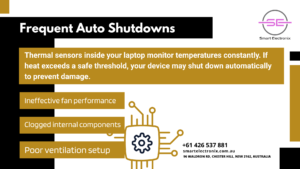
Thermal sensors inside your laptop monitor temperatures constantly. If heat exceeds a safe threshold, your device may shut down automatically to prevent damage.
Possible Causes:
- Ineffective fan performance
- Clogged internal components
- Poor ventilation setup
Smart Electronix Fix: Bring your laptop in for a professional thermal checkup if it shuts down regularly.
Sign #4: Fan Not Spinning at All
A silent fan may seem like a good thing—but not when your laptop is heating up. If your fan isn’t spinning, it’s most likely a hardware issue.
Test:
- Use tools like SpeedFan or HWMonitor to check fan status
- Listen carefully near the fan vent while the system is under load
No sound or movement? Time for a replacement.
Sign #5: Error Messages or BIOS Alerts
Some laptops will display system alerts or BIOS error codes if the fan isn’t working properly. These might appear during startup or when the system is under thermal stress.
Common Warnings:
- “Fan Error”
- “CPU Fan Not Detected”
- “Thermal Shutdown”
These errors should not be ignored. Seek professional service right away.
How to Clean a Laptop Fan (Safely)
If dust is the issue, cleaning the fan might be all you need.
Tools Needed:
- Small Phillips screwdriver
- Compressed air can
- Anti-static brush or cloth
Steps:
- Power down and unplug the device.
- Remove the bottom panel using a screwdriver.
- Hold the fan still and use short bursts of air to dislodge dust.
- Use a brush to remove remaining debris.
- Reassemble and test.
Important: Always ground yourself to avoid static damage.
When to Replace the Fan
Cleaning doesn’t always solve the problem. If the fan still isn’t working, you may need a new one.
Signs You Need a Replacement:
- Fan blades are cracked
- Persistent noise after cleaning
- Fan doesn’t spin even after software prompts
Replacement fans are affordable and easy to source, but installation can be tricky on certain models.
Smart Electronix Fan Services
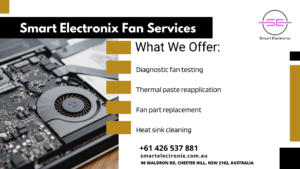
Not comfortable opening your laptop? No worries. Smart Electronix offers professional fan repair and replacement services across Australia.
What We Offer:
- Diagnostic fan testing
- Thermal paste reapplication
- Fan part replacement
- Heat sink cleaning
Book your service now at SmartElectronix.com.au
Preventing Future Fan Issues
- Clean every 3-6 months
- Use your laptop on hard surfaces
- Avoid blocking vents with stickers or accessories
- Monitor internal temperatures regularly with software tools
Final Thoughts
Ignoring fan issues can cost you more than just performance—it can lead to permanent damage to your laptop. If you notice any of these signs, take action early. With simple cleaning or an affordable replacement, your laptop can run smoother and cooler for years to come.
Stay cool and safe with the expert guidance from Smart Electronix. Whether it’s cleaning, diagnostics, or repairs, we’re your go-to team for laptop care in 2025.
Need help with a noisy or broken fan? Visit SmartElectronix.com.au today!



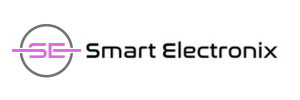




 If your laptop still runs on a traditional hard drive, upgrading to an SSD is a game-changer. SSDs are faster, more durable, and use less power. This upgrade alone can significantly improve boot times, app launches, and file transfers.
If your laptop still runs on a traditional hard drive, upgrading to an SSD is a game-changer. SSDs are faster, more durable, and use less power. This upgrade alone can significantly improve boot times, app launches, and file transfers.




 Step-by-Step Guide:
Step-by-Step Guide: Visit Us:
Visit Us:



 The problem usually comes down to:
The problem usually comes down to:








